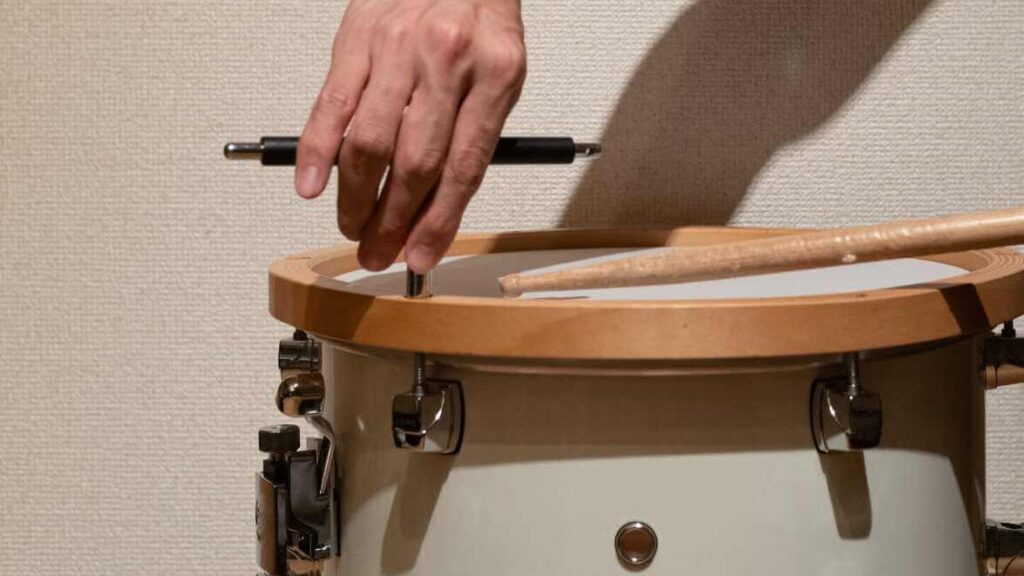Hey there, fellow rhythm enthusiasts! It’s Ron, your go-to buddy for all things drums and percussion. Today, we’re diving deep into the heart of your drum kit—the tom drum. Understanding what goes into making your tom sound the way it does is crucial for any drummer, whether you’re just starting out or you’ve been at it for years. So, let’s break down the anatomy of a tom and explore how each component influences its sound.
The Anatomy of a Tom Drum
The anatomy of a tom drum is a fascinating subject for any drummer, offering insights into the instrument’s design and how it produces its distinctive sound. At its core, a tom drum consists of a shell, two heads (batter and resonant), hoops, tension rods, and lugs. Each component plays a vital role in the drum’s overall tone, resonance, and playability, making understanding these parts crucial for both seasoned and aspiring drummers alike.
Shell Construction and Material
The shell is the body of the drum and the foundation of its sound. Typically crafted from wood, metal, or synthetic materials, the shell’s size, thickness, and material significantly influence the tom’s tonal characteristics. Wood shells, such as maple, birch, and mahogany, are popular for their warm, rich tones, with each wood type offering its unique sound profile. Metal shells, made from steel, aluminum, or brass, produce a brighter, more cutting tone. The construction method, whether ply, stave, or solid, also affects the drum’s resonance and projection.
Drum Heads: The Heart of Tone
The batter head, struck by the drumsticks, and the resonant head, which vibrates in response, work together to define the tom’s sound. Choices between single-ply and double-ply heads can alter the drum’s response and sustain. Coated heads offer a warmer, muted sound, while clear heads deliver a brighter tone with more attack. The tension applied to these heads, controlled by the drummer, allows for fine-tuning of pitch and tonal qualities.
Hoops, Tension Rods, and Lugs: Precision Tuning Components
Hoops hold the drum heads in place and can be made from various materials, including wood, steel, and die-cast metal, each contributing differently to the drum’s sound. Triple-flanged hoops are common and provide a more open tone, while die-cast hoops offer a tighter, more focused sound. Tension rods screw into lugs attached to the shell, allowing drummers to adjust the head tension and, consequently, the pitch of the drum. The number and quality of lugs can affect the drum’s tuning stability and resonance.
The Role of Bearing Edges
The bearing edge, where the drum head meets the shell, is a critical factor in sound production. The angle and condition of the bearing edge influence how the drum head vibrates, affecting the drum’s overall tone and sustain. A sharper edge gives a more focused sound, while a rounder edge produces a warmer tone.
By understanding the anatomy of a tom drum, drummers can make informed choices about their kit configuration, head selection, and tuning approaches. This knowledge not only allows for optimal sound production but also enables drummers to customize their setup to suit their musical style and preferences. Whether aiming for the deep, thunderous toms of rock or the tight, articulate sounds of jazz, the journey begins with a deep dive into the components that make up the soul of the drum.
How Each Component Affects Sound
Every part of the tom drum plays a role in its overall sound. The shell’s size and material define its fundamental pitch and tone. A larger diameter and depth yield lower, boomer tones, while smaller toms sing at higher pitches. The drumheads then add texture and character. A tightly tuned batter head gives a crisp, articulate attack, while a looser resonant head offers a lush, lingering sustain.
But it’s not just about the shell and the heads. The hardware—hoops, tension rods, and lugs—also comes into play, affecting everything from the drum’s tuning stability to its resonance and attack. Die-cast hoops, for example, can focus and tighten the sound, while triple-flanged hoops allow for more ring and overtones.

Tuning Your Tom for Optimal Sound
Tuning is where all these components come together in harmony—or discord. Achieving the perfect pitch and tone from your tom involves balancing the tension across the batter and resonant heads, considering the drum’s natural pitch, and adjusting for the style of music you’re playing. It’s a skill that combines art and science, requiring a good ear and a lot of patience.
The process starts with loosening all tension rods and then gradually bringing them up, checking the pitch at each step. The goal is to find a sweet spot where the drum sings clearly without choking or fluttering. It’s a delicate balance, one that might take a few tries to get right, but the payoff is a set of toms that beautifully complement your drumming.
Dive Deeper Into Drum Tuning
Mastering your tom’s tuning is just the beginning. If you’re keen to explore more about how to make your drums sound their best, from snappy snares to booming bass drums, I’ve got just the thing for you.
For a comprehensive guide that covers everything from selecting the right drumheads to fine-tuning each component for the perfect sound, be sure to check out our in-depth exploration . This guide is your key to unlocking the full potential of your drum kit, ensuring every beat and fill resonates exactly how you envision.




